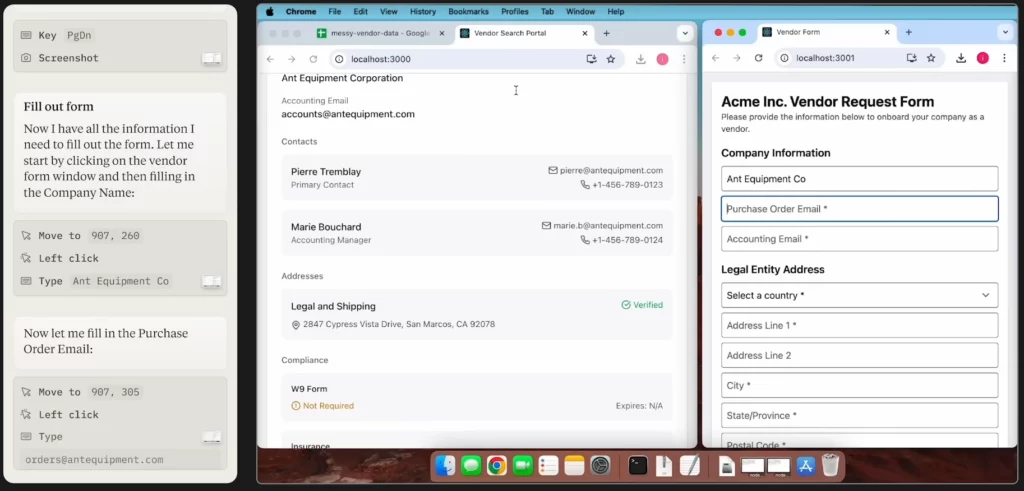Alright folks, sit back because we’re about to dive into the wonders of AI’s latest upgrade. You’d think that after all these years of making machines almost as smart as us, the geniuses behind Claude decided: “Nah, let’s give them even more power.” What could possibly go wrong, right?
Claude 3.5 Sonnet—and if that’s not the most poetic name for an AI ever, I don’t know what is—is here to make you feel even less competent. And get this: it now USES A COMPUTER. Yep, not only does it think and write like a human (sort of), but now it clicks, types, and navigates like one too. Just what we needed—a robot to outdo us at our own office jobs.
Claude 3.5 Sonnet: Can It Actually Use a Computer?
You heard that right! Claude 3.5 Sonnet can now scroll, drag, and even fill out forms for you. It’s not just your average chatbot anymore; this thing is running your software while you contemplate your life choices.
But here’s the kicker: it’s not perfect (yet). Think of it like when grandma tries to figure out Zoom. Sometimes it’s a little slow, and occasionally it clicks the wrong button. Developers are all over it though, using this computer-savvy AI to handle tasks nobody wants to do, like filling in endless spreadsheets or testing code.

What’s Special About Claude 3.5 Haiku?
Well, if you’re wondering what on earth a Haiku is doing in this discussion, don’t worry. Claude 3.5 Haiku is all about speed and affordability—because you know, we definitely needed AI to do things even faster so we can feel worse about how slow we are. This tiny but mighty model claims to beat its predecessors, Claude 3 Opus and the original Claude 3 Sonnet, on many fronts, all while being super affordable.
Should You Be Scared of These AI Upgrades?
Honestly? Maybe. While it’s fun to joke about an AI taking over your job, Claude 3.5 Sonnet and Haiku are pretty impressive. They’ve improved their reasoning skills (no more dumb AI errors, yay?), and they’re good at coding too. In fact, Claude 3.5 Sonnet can handle complex tasks like debugging and translating code from one language to another. So yeah, maybe start brushing up on some skills that robots haven’t learned yet, like folding fitted sheets.
Why You Should Care About This (Even if You Don’t Want To)
Let’s be real: this is all cool tech stuff, but you’re probably wondering why you should care. Well, Claude 3.5 Sonnet and Haiku aren’t just for developers or tech nerds. Businesses are jumping on this AI revolution because it saves time and makes processes smoother. Imagine automating the boring stuff, like filling out reports or managing tons of data, while you sit back and watch the magic happen.
And the best part? It’s all done in the cloud. So your computer doesn’t even have to break a sweat. These new models are perfect for anyone needing fast, efficient AI help without the complexity of managing giant systems.

So, Is Claude 3.5 Going to Rule the World?
No, not yet. Claude 3.5 Sonnet’s ability to use a computer is still in its beta phase. Think of it like a kid learning to ride a bike—it might crash a couple of times before it starts cruising smoothly. But, as it learns, the potential is HUGE. Some companies are already using it to build apps, manage tasks with hundreds of steps, and automate boring workflows.
Final Thoughts: Claude’s Not Here to Play—It’s Here to Work (For You)
So, what’s the takeaway? If you’re not already looking into how AI can help you do your job, you might want to start. Claude 3.5 Sonnet and Haiku are blazing a trail for smarter, faster, and more capable AI assistants. And while they’re not perfect (yet), it won’t be long before they’re automating more tasks than you ever thought possible.
If you’re a business owner, developer, or just someone who enjoys seeing tech evolve at light speed, Claude 3.5 Sonnet and Haiku should definitely be on your radar.

